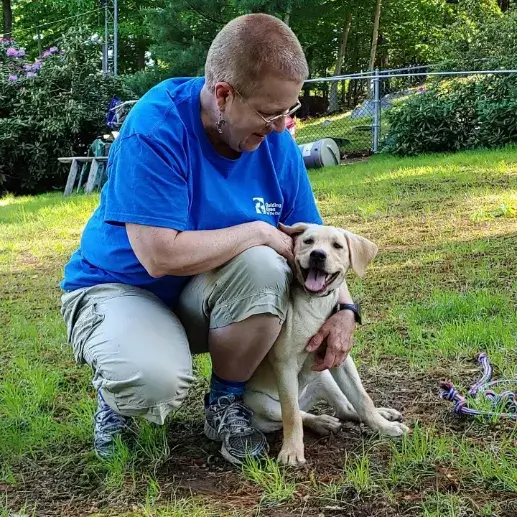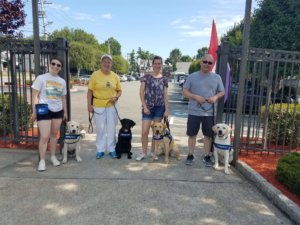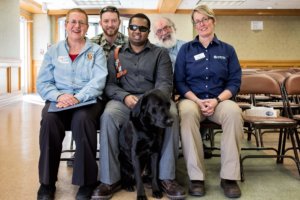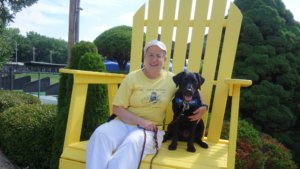Main Menu
About the author: Elliana Russell is a recent high school graduate from Indiana. She enjoys reading books and drawing. She plans to pursue a career in Creative Writing after attending Purdue University. Elliana wrote this profile in conjunction with Ruth Ladd as an assignment in a senior composition class taught by Kathy Nimmer, a Guiding Eyes graduate who is partnered with Nacho, a yellow lab guide dog.
 It is estimated that there are approximately 10,000 guide dogs currently working in the United States. Some are undergoing training, while others are out there helping individuals with visual impairments. Of course, all of these dogs would not have their respected jobs if it weren’t for their devoted raisers and trainers. Ruth Ladd, an Eastern Massachusetts raiser who loves to sew, garden, and read, helps raise puppies for Guiding Eyes for the Blind, leading them down the initial path of becoming a guide dog. A puppy raiser is an individual who provides a home and training ground for a hand-selected puppy in order for them to thrive in their jobs. With proper care and discipline, these puppies will grow up to help the blind in overcoming daily obstacles. Recently retired, Ruth has enjoyed raising many puppies and makes sure that each dog trained is given love and time. Part of raising a puppy for this program is establishing a bond between human and animal, which has caused Ruth’s life to be changed and enriched through puppy raising.
It is estimated that there are approximately 10,000 guide dogs currently working in the United States. Some are undergoing training, while others are out there helping individuals with visual impairments. Of course, all of these dogs would not have their respected jobs if it weren’t for their devoted raisers and trainers. Ruth Ladd, an Eastern Massachusetts raiser who loves to sew, garden, and read, helps raise puppies for Guiding Eyes for the Blind, leading them down the initial path of becoming a guide dog. A puppy raiser is an individual who provides a home and training ground for a hand-selected puppy in order for them to thrive in their jobs. With proper care and discipline, these puppies will grow up to help the blind in overcoming daily obstacles. Recently retired, Ruth has enjoyed raising many puppies and makes sure that each dog trained is given love and time. Part of raising a puppy for this program is establishing a bond between human and animal, which has caused Ruth’s life to be changed and enriched through puppy raising.
 This volunteer work is no easy task, and some may find the training to be quite tiring. Ruth, on the other hand, is invigorated with raising her puppies, and she is enthralled to take on new challenges. No puppy given to them will be getting away with any behavioral issues, and Ruth makes sure that the harder these dogs work, the more rewards will be given. Instead of going the traditional route of raising a pet, she runs things differently when it comes to these pups. One might question why she decided to go through such hard work, and how it’s all for no pay. Ruth believes that the payment is not physical, but an experience that fulfills her as a caretaker.
This volunteer work is no easy task, and some may find the training to be quite tiring. Ruth, on the other hand, is invigorated with raising her puppies, and she is enthralled to take on new challenges. No puppy given to them will be getting away with any behavioral issues, and Ruth makes sure that the harder these dogs work, the more rewards will be given. Instead of going the traditional route of raising a pet, she runs things differently when it comes to these pups. One might question why she decided to go through such hard work, and how it’s all for no pay. Ruth believes that the payment is not physical, but an experience that fulfills her as a caretaker.
 Before her volunteer work with dogs really kicked off, she was admiring a woman and a guide dog next to her on the local bus. Soon, both women were enveloped in a conversation about dogs, and the woman claimed that Ruth would make a great puppy raiser. Ruth was confused, for she had only described her pets and how they were trained for tasks such as hunting or simple commands. It came to her realization that guide dogs are not born knowing how to do that job. The dog she was sitting next to on the bus had to undergo much training in order to help the woman he was with. Inspired, Ruth rushed home to her husband and told him about her encounter on the bus. She had been raising golden retrievers as pets since 1973 and wanted to further this raising as a volunteer job with a purpose.
Before her volunteer work with dogs really kicked off, she was admiring a woman and a guide dog next to her on the local bus. Soon, both women were enveloped in a conversation about dogs, and the woman claimed that Ruth would make a great puppy raiser. Ruth was confused, for she had only described her pets and how they were trained for tasks such as hunting or simple commands. It came to her realization that guide dogs are not born knowing how to do that job. The dog she was sitting next to on the bus had to undergo much training in order to help the woman he was with. Inspired, Ruth rushed home to her husband and told him about her encounter on the bus. She had been raising golden retrievers as pets since 1973 and wanted to further this raising as a volunteer job with a purpose.
 Ruth began her official Guiding Eyes volunteer work in 1999 and was given her first puppy after attending classes. Knowing what and how the organization ran itself was important knowledge, and she needed to meet the requirements in order to take part in such a crucial activity. As expected, both Ruth and the puppy needed time in order to get used to their new living arrangement. Owning and training a puppy for such a cause can be nerve-wracking, but Ruth did not want to give up. She did not have any long term goals for her first puppy, but she wanted to make sure that it was trained properly. Before 1999, choke collars and no treat rewards were used with dogs in order to gain their compliance in training. After Guiding Eyes changed their approach to positive reinforcement techniques, Ruth found that raising a puppy is easier, but only if they follow certain steps: flat collars only, use of treats, and “use of you”. Taking heed of these steps brought Ruth and her pups closer together as trainer and learner, and greatly improved Ruth’s experience. Not only did this help Ruth, the dogs began to work with her not because they were forced to, but because they wanted to.
Ruth began her official Guiding Eyes volunteer work in 1999 and was given her first puppy after attending classes. Knowing what and how the organization ran itself was important knowledge, and she needed to meet the requirements in order to take part in such a crucial activity. As expected, both Ruth and the puppy needed time in order to get used to their new living arrangement. Owning and training a puppy for such a cause can be nerve-wracking, but Ruth did not want to give up. She did not have any long term goals for her first puppy, but she wanted to make sure that it was trained properly. Before 1999, choke collars and no treat rewards were used with dogs in order to gain their compliance in training. After Guiding Eyes changed their approach to positive reinforcement techniques, Ruth found that raising a puppy is easier, but only if they follow certain steps: flat collars only, use of treats, and “use of you”. Taking heed of these steps brought Ruth and her pups closer together as trainer and learner, and greatly improved Ruth’s experience. Not only did this help Ruth, the dogs began to work with her not because they were forced to, but because they wanted to.
 Ruth’s journey into puppy raising spiked as the years progressed, with 8 dogs who became guides and more currently in training. There are three methods to her training, as Ruth states, “In our training, we use the three Ds: Distance, duration, and distraction. If you are too close to a distraction the puppy may not be able to disconnect from the distraction and focus back on me so we need to get further away.” She continues, “Duration means how long a pup can maintain a skill (sit, down, etc.). Distraction just means how distracting something is.” Through this training, the pups are given the basic skills of being a guide dog. By establishing these skills, dogs are able to stay close to their owners’ side, even if it means simply watching the world go by. The puppies are not the only ones going through training, Ruth also has to break habits and get rid of preconceptions while she raises a Guiding Eyes puppy. She explains, “I had to unlearn the training we used in obedience classes and learn how it was done with future guide dogs. I remember having to break myself from using the word “heel” to get the dog to walk beside me because Guiding Eyes only uses that to have the dog come and sit next to me.” She adds, “I also had to break myself of doing sharp corners as are required in obedience competitions.” This journey not only improved the dogs, but it also gave Ruth a life lesson: You cannot expect life to happen to you, you have to make life happen.
Ruth’s journey into puppy raising spiked as the years progressed, with 8 dogs who became guides and more currently in training. There are three methods to her training, as Ruth states, “In our training, we use the three Ds: Distance, duration, and distraction. If you are too close to a distraction the puppy may not be able to disconnect from the distraction and focus back on me so we need to get further away.” She continues, “Duration means how long a pup can maintain a skill (sit, down, etc.). Distraction just means how distracting something is.” Through this training, the pups are given the basic skills of being a guide dog. By establishing these skills, dogs are able to stay close to their owners’ side, even if it means simply watching the world go by. The puppies are not the only ones going through training, Ruth also has to break habits and get rid of preconceptions while she raises a Guiding Eyes puppy. She explains, “I had to unlearn the training we used in obedience classes and learn how it was done with future guide dogs. I remember having to break myself from using the word “heel” to get the dog to walk beside me because Guiding Eyes only uses that to have the dog come and sit next to me.” She adds, “I also had to break myself of doing sharp corners as are required in obedience competitions.” This journey not only improved the dogs, but it also gave Ruth a life lesson: You cannot expect life to happen to you, you have to make life happen.
 Ruth has a heart full of love for these dogs and is willing to go the extra mile in order for them to succeed in their careers. Caring for dogs has been built into her life for many years, and by taking this step into puppy raising, she has not only learned about Guiding Eyes puppies but also more about herself. She is aware that no humans or dogs are perfect, but the experience is what matters, and it is what allows both raiser and dog to improve their abilities. Ruth knows that not all dogs are cut out for the job, but she perseveres through those tough times until something works. Even though she has to give up her trained dogs to Guiding Eyes for the Blind, she finds that the experiences are much more important than keeping the dog. In a way, Ruth and her dogs are truly guiding us into a world of love, trust, and companionship.
Ruth has a heart full of love for these dogs and is willing to go the extra mile in order for them to succeed in their careers. Caring for dogs has been built into her life for many years, and by taking this step into puppy raising, she has not only learned about Guiding Eyes puppies but also more about herself. She is aware that no humans or dogs are perfect, but the experience is what matters, and it is what allows both raiser and dog to improve their abilities. Ruth knows that not all dogs are cut out for the job, but she perseveres through those tough times until something works. Even though she has to give up her trained dogs to Guiding Eyes for the Blind, she finds that the experiences are much more important than keeping the dog. In a way, Ruth and her dogs are truly guiding us into a world of love, trust, and companionship.